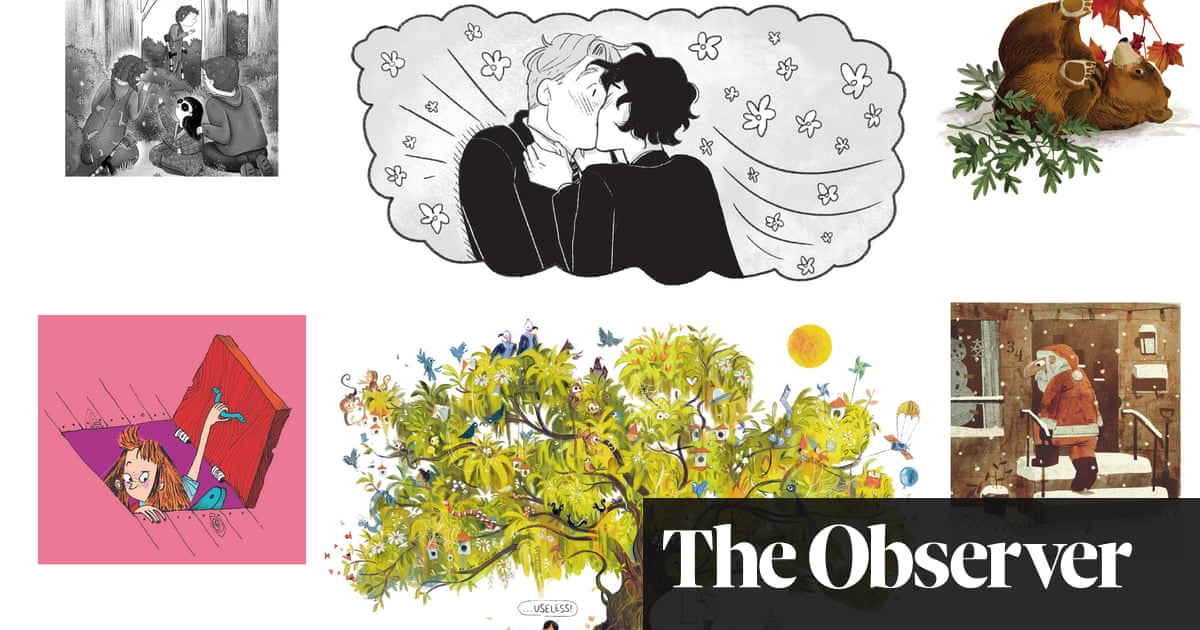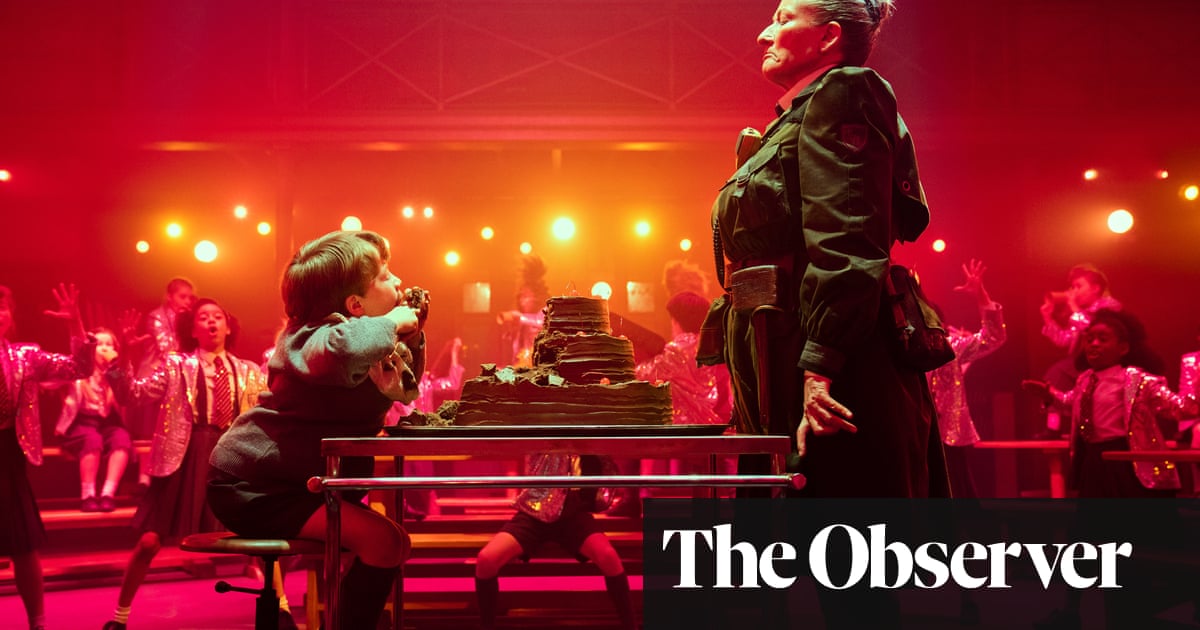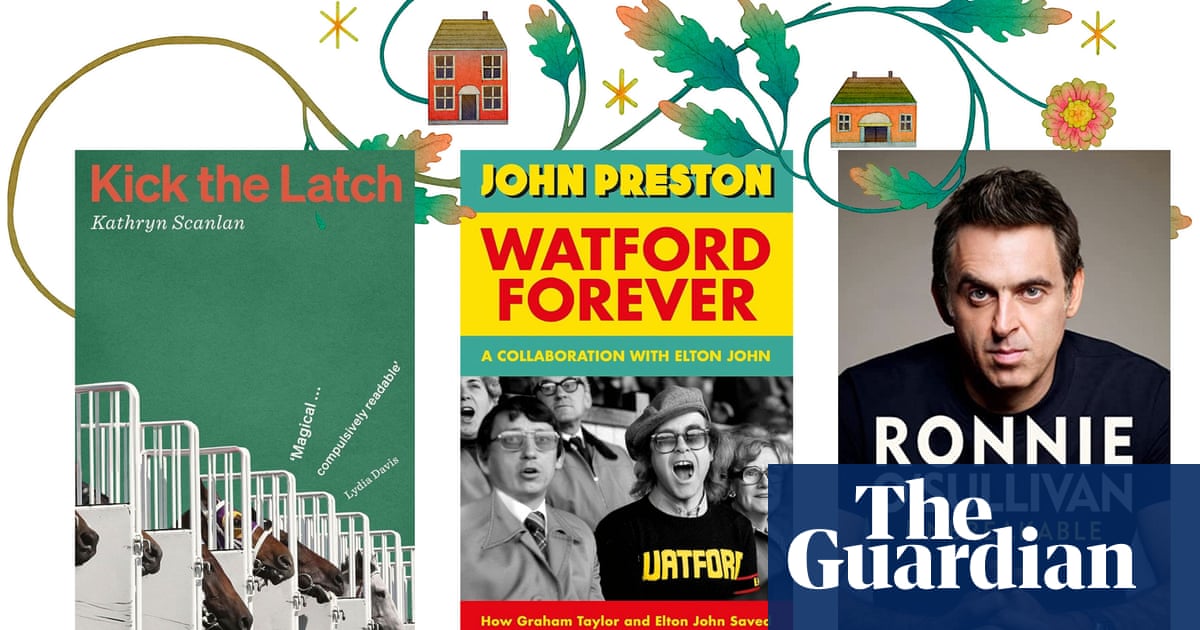
Imogen Carter’s picture books of the year
After the years of huddling at home, it was time to party. There were landmark birthdays: Julia Donaldson and Axel Scheffler toasted 30 years of working together with a hit exhibition at the Lowry in Salford (until 1 Jan) and Benji Davies marked 10 years of bestseller The Storm Whale with a shindig and a fantastic sequel, The Great Storm Whale (Simon and Schuster). Elsewhere, pioneers were celebrated: a British Library show honouring Malorie Blackman’s career threw open its doors, free of charge and ready to inspire the next generation (until 25 Feb), while Michael Rosen won the 2023 PEN Pinter prize with the judges praising his “rare, invaluable gift: the ability to address the most serious matters of life in a spirit of joy, humour and hope”.
Indeed, while serious matters and gloomy times often seemed inescapable in the real world, some of the warmest and wittiest picture book authors came out swinging, with titles reminding children to laugh, rise high and face their fears. Rosen himself published the wonderful The Big Dreaming (Bloomsbury), featuring illustrator Daniel Egnéus’s gorgeous wide-eyed little bear stocking up on extra dreams in case he ran out during hibernation. Nadia Shireen’s hilarious Geoffrey Gets the Jitters (Puffin) depicted the fears of its titular hero as wibbly-wobbly worms that Geoffrey eventually learned to tackle with deep breaths and big chats. The back page’s “Very Useful Guide”, examining types of worry from the Frazzle to the Fret, probably ought to go on the fridge to help the anxious of all ages through the festive season.
Guaranteed to bring Christmas cheer, the latest from deadpan humorists Mac Barnett and Jon Klassen, How Does Santa Go Down the Chimney? (Walker), explored one of life’s biggest mysteries via a series of childlike questions. Does Santa stretch out like toffee to get down the chimney? Or does one of the reindeers give him a shove? With Klassen’s droll, sooty illustrations, and just a little naughtiness, it’s a real schmaltz-free treat.
Imaginative, longer form illustrated tales about home life came from Sophie Dahl with Madame Badobedah and the Old Bones (Walker), and novelist Rose Tremain’s first picture book, Iron Robin (Puffin). Dahl’s elegant, crimson-haired adventurer, beautifully depicted by illustrator Lauren O’Hara, first rocked up at Mabel’s parents’ seaside B&B in 2019’s Madame Badobedah and this year’s sequel found her and Mabel on a mission to return a precious gem. Iron Robin, about the friendship between a boy called Oliver and a rusty metal bird, felt soaked in folklore and magic. Magnificent layered drawings by Richard Jones added to its richness and depth.
While parties and exhibitions celebrated literary stars, there was also plenty of room this year for new talents to make an entrance. My favourite debut came from Sarthak Sinha with his ecstatic Farah Loves Mangos (Flying Eye), about a young girl and the cherished fruit on her grandpa’s tree that she helps cultivate with singing and hugs. Bursting with a crazy, cartwheeling energy and a reminder to deal with what life throws at you, its pages glow even on the darkest days.
Kitty Empire’s chapter books of the year
First, a catch-up with old friends at this convivial time of year – over 2023 there were a number of great sequels. In 2022’s The Last Bear, Hannah Gold’s furry protagonist had made it back to the Arctic. But the Arctic is no safe place, as we discovered in Finding Bear (HarperCollins).
There were more: Richard Lambert’s excellent The Republic of Dreams (Everything With Words) plunged readers back into the parallel worlds inhabited by young Toby and Tamurlaine in his previous work, Shadow Town. Nicola Davies’s gripping 2021 eco-thriller The Song That Sings Us spawned a prequel in Skrimsli (Firefly Press), exploring the backstory of the brave, cantankerous ship’s captain-cum-tiger. And Nigerian-German author Efua Traoré made it a hat-trick of standalones with her third novel, One Chance Dance (Chicken House) about a high-stakes dance competition in Lagos.
Hearts gladdened, too, at the news of the publication of The Incredible Adventures of Gaston Le Dog (Walker), the book that Michael Rosen had hoped to write if he survived Covid. Fellow kid-lit supremo Katherine Rundell’s Impossible Creatures (Bloomsbury) was one of the most highly anticipated books of 2023: it did not disappoint, bagging the Waterstones overall book of the year award and Foyles children’s book of the year.
Publishing sensation Angie Thomas (The Hate U Give) proved she could animate contemporary themes for younger readers as well. Her Nic Blake and the Remarkables: The Manifestor Prophecy (Walker) had unruly figures from folklore foxing a set of gifted characters in their quest to clear a relative’s name. Horror remains a big teen trend: SJ Wills faded the edges between middle grade and YA with her not-too-scary werewolf thriller, Bite Risk (Simon & Schuster).
Stories from closer to home sang out too. Natasha Farrant is a dab hand at world-building in the here and now, and The Rescue of Ravenwood (Faber) reminded us that families are often constructed out of available materials – a bit like the dilapidated household that brave children are trying to save from shady grownup dealings. Lesley Parr’s Where the River Takes Us (Bloomsbury) offered a Welsh setting in a time of hardship with parallels to our own austerity-filled present, and more kids solving real-world problems. Over in nonfiction, Shelina Janmohamed’s Carnegie medal-nominated Story of Now: Why We Need to Talk About the British Empire (Welbeck) was a clear-eyed analysis of the after-effects of colonialism that could not be more compelling.
A slew of children’s authors shrugged off boring old gender binaries in a clutch of warm, resourceful books. Jamie (Hachette) by LD Lapinski explored the options open to a gender non-conforming child at the end of year 6 in a town where there are only two secondary schools: one for girls and one for boys. Lisette Auton’s The Stickleback Catchers (Puffin) was actually a magic realist fight to save a beloved grandmother from dementia. But dialect, disability, neurodivergence and gender-nonconformity were all woven incidentally into this open-hearted book.
Towering over allcomers, though, was this year’s sharpest offering: The Swifts (Penguin Random House) by newcomer Beth Lincoln. This “gleeful gothic” tale about language and identity took in well-worn tropes such as eccentric families and secret-filled old houses. But Lincoln romped through her thriller plot, scattering pronouns, undermining cliches and delighting in language as she went.
Fiona Noble’s YA books of the year
Young adult books have enjoyed another bumper year, boosted by the burgeoning “romantasy” genre and the BookTok community. YA crime queen Karen M McManus returned with One of Us Is Back (Penguin), Christopher Paolini rebooted his epic Eragon series with Murtagh (Penguin) and Suzanne Collins’s The Hunger Games (Scholastic) saw a resurgence courtesy of prequel movie The Ballad of Songbirds and Snakes.
American names may top the bestseller charts but some of 2023’s finest books were to be found closer to home. Bookending the year with two deliciously plotted thrillers came new talent Ravena Guron. In January’s This Book Kills (Usborne), British Indian scholarship student Jess Choudhary investigates murder at her elite boarding school, while Catch Your Death (Usborne) sees three girls marooned by a snowstorm in the mansion of a family of liars. A contemporary locked-room mystery with Agatha Christie-style thrills, it is a must-read for fans of Holly Jackson.
The writer and Everyday Sexism Project founder Laura Bates made her first foray into YA fantasy with Sisters of Sword and Shadow (Simon & Schuster). In Arthurian England, Cass flees her destiny of an arranged marriage and joins the Sisterhood of Silk Knights, a group of women training together to protect their community and right the wrongs of men. There’s thrilling combat and deadly feuds but this is ultimately a book brimming with feminist joy as girls discover independence and the value of female friendship. There’s more historical fiction in Wild Song (David Fickling Books), in which Candy Gourlay looked to the early 20th century and a Filipino tribe who attended the St Louis World Fair in the US. A companion novel to the acclaimed Bone Talk, this rich, immersive adventure tackles racism and inequality, narrated by an unforgettable heroine.
One of the year’s most memorable debuts was Catfish Rolling (Zephyr) by Clara Kumagai. Since losing her mother in the 2011 Japanese earthquake, grief-stricken Sora is aimless, wandering into strange pockets of fractured time created by the disaster. It is an original and ambitious coming-of-age novel told against the rich backdrop of Japanese folklore and culture. Magic realism was also interwoven into the narrative of Blessing Musariri’s All That It Ever Meant (Zephyr). Fourteen-year-old Mati takes a trip to Zimbabwe with her siblings and father, coming to terms with grief and the challenges of a life lived between two cultures, guided by an enigmatic gender-neutral spirit, visible only to her. A beautifully written, emotionally resonant novel about family, grief and identity.
Finally, published just in time for Christmas, came Heartstopper Volume 5 (Hachette). In what creator Alice Oseman says will be the penultimate outing of the graphic novel series, Nick and Charlie are very much in love… but what happens next? As they discuss taking their relationship to the next stage, Nick’s university plans cast a long shadow. Nobody writes teenagers like Oseman: her characters feel so real and she handles their struggles – relationships, sex, family and mental illness – with great care and respect. Funny, romantic and life-affirming, it is the perfect stocking filler for any teenager in your life.
To browse all children’s books included in the Guardian and Observer’s best books of 2023 visit guardianbookshop.com. Delivery charges may apply







